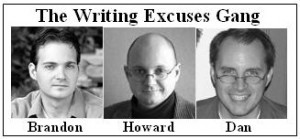 The Writing Excuses guys have posted another good podcast: this one on world-building a history.
The Writing Excuses guys have posted another good podcast: this one on world-building a history.
I wanted to add a few comments. You’ll notice that a lot of the blurbs for my novel mention my world-building, so I guess it’s a strength in my writing. However, I don’t write huge world building documents in the pre-draft stage. I do write some history, of course. But I don’t think it would take up more than a few pages. A lot of world-building happens in draft.
It seems to me there are two levels of “history” and a lot of it can be done on-the-fly.
1. There are small hints of CHANGE in places and people.
Dave Wolverton taught me this one. You come upon an orchard in the woods that’s gone wild and is overgrown. It takes two lines to describe it and it gives a strong feel of past. The reader wonders who was there, what happened. Maybe you tell them. Maybe you don’t. You mention that the village Knight used to be fat but is wasting or vice versa. I find I can do these types of things usually on-the-fly as I’m writing. And I don’t need to know much about them. I just ask myself if anything has changed with the location or characters in the current scene.
A few touches of CHANGE throughout the novel give a strong sense of history.
2. There are events, groups, and individuals who impact or impacted your characters and their community in large ways.
There was a war with a neighboring country not five years ago. Your characters have to travel through that land, or maybe half the male population went to war and never came back. Or perhaps your character lost his sister in a drowning he could have prevented. Or he lost her to slavers. Or perhaps there is a secret police (like the Roman couriers) who arrived two years ago.
Again, many of these things can be thought up on the fly as you look for conflict and the stories of a place and community. However, I’ve found that it helps to ask a few key questions in the pre-draft stage to lay some (NEVER ALL) the groundwork.
— What kind of conflicts do these nations and groups have?
— What events have had a large impact on my character and his community? They can be terrible or wonderful events.
— Who in the community are my characters friends and enemies? What’s the history?
— What are the local and regional stories of events (or people) that were eccentric, odd, mysterious, dangerous, or revolutionary?
I never get all my answers up front. But I will get some. And then as I write I just keep in mind that it’s neat to indicate change every once in a while and to briefly bring up stories from the past that relate to the current matter at hand in the present story.
Finally, I really like the idea the Writing Excuses guys brought up of sharing multiple explanations for an event (multiple histories) when it fits and to include more than one cause, although I’m pretty sure the 80/20 rule applies to causation.















I found the ‘multiple explanations for an event’ works great when you have 1+ POVs. In Book 6 or 7 of Wheel of Time series, several of the characters refer to an incident that must have happened only a few months ago. Yet different POVs assume different things due to mis/no-communication.
Unless the main character is being ‘lectured’ or ‘told’ by someone else, when s/he had already mentioned to the readers otherwise, how would you as a writer make sure the readers know of these multiple explanations?
I’m not sure if that even makes sense.
I think your question makes sense. But I don’t think it requires more than one pov.
“Jack walked into the room. It was full of Utlanders. He just hoped these weren’t that group of Utlanders who believed…”
The main pov character can be aware of other explanations, even if he doesn’t believe them. Or if he’s not sure which one is right.
A good example of one way to handle 2 explanations with 1 pov is Orson Card’s STONEFATHER novelette. There are two groups with two different versions of an event. And it comes across in a very normal way.